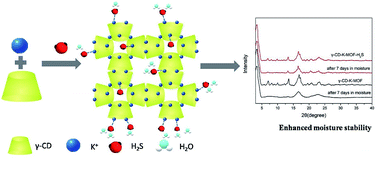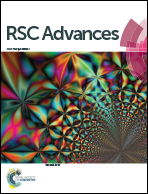Facile stabilization of a cyclodextrin metal–organic framework under humid environment via hydrogen sulfide treatment†
Abstract
Increasing resistance to humid environments is a major challenge for the application of γ-CD-K-MOF (a green MOF) in real-world utilisation. γ-CD-K-MOF–H2S with enhanced moisture tolerance was obtained by simply treating MOF with H2S gas. XPS, Raman and TGA characterizations indicated that the H2S molecules coordinated with the metal centers in the framework. H2S acting as a newly available water adsorption potential well near the potassium centers protects the metal–ligand coordination bond from attack by water molecules and thus improves the moisture stability of MOF. After 7 days exposure in 60% relative humidity, γ-CD-K-MOF–H2S retained its crystal structure and morphology, while γ-CD-K-MOF had nearly collapsed. In addition, the formaldehyde uptake tests indicated that γ-CD-K-MOF retain their permanent porosity after interaction with H2S. This simple and facile one-step strategy would open a new avenue for preparation of moisture stable MOFs for practical applications.



 Please wait while we load your content...
Please wait while we load your content...